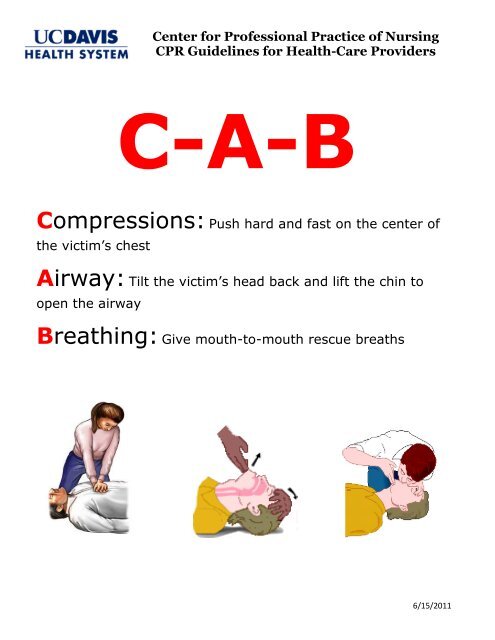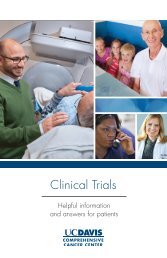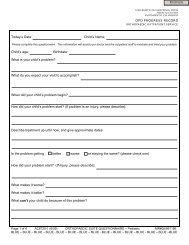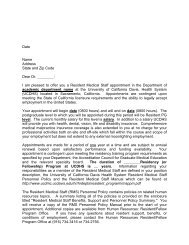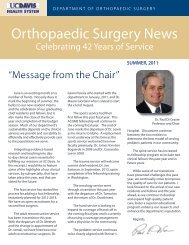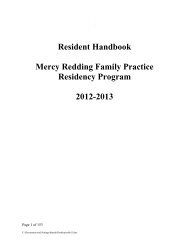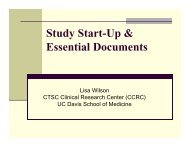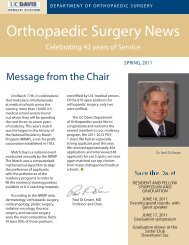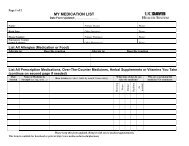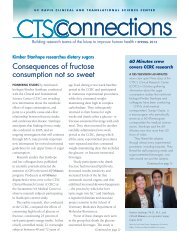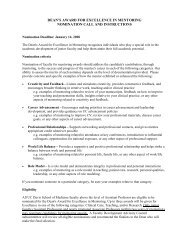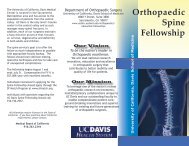Center for Professional Practice of Nursing CPR Guidelines for ...
Center for Professional Practice of Nursing CPR Guidelines for ...
Center for Professional Practice of Nursing CPR Guidelines for ...
You also want an ePaper? Increase the reach of your titles
YUMPU automatically turns print PDFs into web optimized ePapers that Google loves.
<strong>Center</strong> <strong>for</strong> <strong>Pr<strong>of</strong>essional</strong> <strong>Practice</strong> <strong>of</strong> <strong>Nursing</strong><strong>CPR</strong> <strong>Guidelines</strong> <strong>for</strong> Health-Care ProvidersC-A-BCompressions: Push hard and fast on the center <strong>of</strong>the victim’s chestAirway: Tilt the victim’s head back and lift the chin toopen the airwayBreathing: Give mouth-to-mouth rescue breaths6/15/2011
<strong>Center</strong> <strong>for</strong> <strong>Pr<strong>of</strong>essional</strong> <strong>Practice</strong> <strong>of</strong> <strong>Nursing</strong><strong>CPR</strong> <strong>Guidelines</strong> <strong>for</strong> Health-Care Providers<strong>CPR</strong> GUIDELINES FOR ADULTSASSESSUnresponsive: No breathing or no normal breathing (only gasping)Activate the EMS (call 911). Get the AED if available and return tothe victimIf second rescuer is available send them to get help and the AEDCheck Pulse: Check the victim's pulse at the carotid artery <strong>for</strong> nomore than 10 secondsDELIVER HIGH QUALITY <strong>CPR</strong>Start compressions within 10 seconds <strong>of</strong> identifying cardiacarrestCompress chest at least 2 inches, 30 times on the lower half <strong>of</strong>the breastboneoCompress 2-handed, with one hand on top <strong>of</strong> the otherCompress at a rate <strong>of</strong> at least 100 compressions per minuteoEach set <strong>of</strong> 30 compressions should take 18 seconds or lessAllow complete chest recoil after each compressionMinimize interruptions in chest compressions to less than 10seconds<strong>CPR</strong> ratio is 30 compressions to 2 breathsoRatio stays the same <strong>for</strong> one-person & two-person <strong>CPR</strong>In two-person <strong>CPR</strong> the rescuers should change positions afterevery 2 minutes6/15/2011
GUIDELINES FOR ADULTS<strong>Center</strong> <strong>for</strong> <strong>Pr<strong>of</strong>essional</strong> <strong>Practice</strong> <strong>of</strong> <strong>Nursing</strong><strong>CPR</strong> <strong>Guidelines</strong> <strong>for</strong> Health-Care ProvidersPROVIDE EFFECTIVE BREATHSOpen the victim’s airway. Use the appropriate technique to openthe airwayooHead Tilt-Chin Lift: tilt the head back and lift the chinJaw Thrust: If a head or neck injury is suspectedDeliver each rescue breath over 1 secondThe victim’s chest should rise with each breathAvoid excessive ventilationUse bag-valve mask or barrier device if availableOnce an advanced airway is placed, continuous compressions arepre<strong>for</strong>med without pause <strong>for</strong> ventilation. Ventilations aredelivered at a rate <strong>of</strong> 1 breath every 6-8 secondsIf there is a pulse and the victim is not breathing:Provide rescue breathing: 1 breath every 5-6 seconds(10-12 breaths/minute)CONTINUE HIGH QUALITY <strong>CPR</strong>Continue cycles <strong>of</strong> compressions and ventilation at a ratio <strong>of</strong> 30:2Healthcare Providers should rotate compressors every 2 minutesAttach and use AED as soon as availableMinimize interruptions in chest compressionso Limit to less than 10 secondsHealth care providers continue effective chest compressions/<strong>CPR</strong>until return <strong>of</strong> spontaneous circulation (ROSC) or termination <strong>of</strong>resuscitative ef<strong>for</strong>ts6/15/2011
<strong>Center</strong> <strong>for</strong> <strong>Pr<strong>of</strong>essional</strong> <strong>Practice</strong> <strong>of</strong> <strong>Nursing</strong><strong>CPR</strong> <strong>Guidelines</strong> <strong>for</strong> Health-Care Providers<strong>CPR</strong> GUIDELINES FOR INFANTS(Age: Birth to 1 year)ASSESSUnresponsive: No breathing or no normal breathing (only gasping)Send second rescuer to activate the EMS (call 911) and get the AEDIf alone, remain with victim and provide 2 minutes <strong>of</strong> <strong>CPR</strong> be<strong>for</strong>eactivating the EMSCheck Pulse: Check the victim's pulse at the brachial artery <strong>for</strong> nomore than 10 secondsoIf the victim’s heart rate is less than 60 beats per minutewith signs <strong>of</strong> poor perfusion, start <strong>CPR</strong>DELIVER HIGH QUALITY <strong>CPR</strong>Compress chest at least 1/3 the depth <strong>of</strong> the chest (about 1 ½inches), 30 times just below the nipple lineoCompress with the Two-Finger compression technique <strong>for</strong>infantsCompress at a rate <strong>of</strong> at least 100 compressions per minuteoEach set <strong>of</strong> 30 compressions should take 18 seconds or lessAllow complete chest recoil between each compressionMinimize interruptions in chest compressions to less than 10seconds<strong>CPR</strong> ratio <strong>for</strong> one-person <strong>CPR</strong> is 30 compressions to 2 breaths<strong>CPR</strong> ratio <strong>for</strong> two-person <strong>CPR</strong> is 15 compressions to 2 breathsooEach set <strong>of</strong> 15 compressions should take 9 seconds or lessUse the Two-Thumb Encircling Technique <strong>for</strong> compressionsIn two-person <strong>CPR</strong> the rescuers should change positions afterevery 2 minutesAfter 2 minutes, activate the EMS (call 911) if not already doneand get the AED6/15/2011
AED GUIDELINES<strong>Center</strong> <strong>for</strong> <strong>Pr<strong>of</strong>essional</strong> <strong>Practice</strong> <strong>of</strong> <strong>Nursing</strong><strong>CPR</strong> <strong>Guidelines</strong> <strong>for</strong> Health-Care ProvidersEarly defibrillation is critical <strong>for</strong> victims <strong>of</strong> sudden cardiac arrest.The earlier defibrillation occurs, the higher the survival rate. ForVF victims, survival rates are highest when immediate bystander<strong>CPR</strong> is provided and defibrillation occurs within 3 to 5 minutes <strong>of</strong>collapse.Attach and use the AED as soon as it is available. Minimizeinterruptions in chest compressions be<strong>for</strong>e and after each shock.AED use in children and infants:For children from 1 to 8 years old, an AED with a pediatric doseattenuatorsystem should be used if available. If an AED with a doseattenuator is not available, a standard AED may be used (including adultpads)For infants
AED GUIDELINES<strong>Center</strong> <strong>for</strong> <strong>Pr<strong>of</strong>essional</strong> <strong>Practice</strong> <strong>of</strong> <strong>Nursing</strong><strong>CPR</strong> <strong>Guidelines</strong> <strong>for</strong> Health-Care ProvidersSPECIAL SITUATIONS WHEN USING AN AEDHairy Chest:The AED pads may stick to the hair and not stick to the chest. Make sure topress firmly on each pad. If they do not stick to the chest, shave the area withthe razor in the AED carrying case and put on a new set <strong>of</strong> pads.Water:Do not use an AED in water. If the victim is in water, pull the victim out <strong>of</strong> thewater. If the victim’s chest is covered with water, wipe the chest be<strong>for</strong>eattaching the pads.Pacemaker:You can identify pacemakers because they create a hard lump beneath the skin<strong>of</strong> the upper chest. Place the AED pad at least 1 inch to the side <strong>of</strong> thepacemaker.Medicinal Patches:Do not place AED pads on top <strong>of</strong> a medication patch. Remove the patch andwipe the area clean be<strong>for</strong>e attaching the AED pads. Make sure not to touch themedicine with bare hands.Flammable Items:Make sure the scene is safe and the victim is not near flammable items. If youfind a victim in a garage with flammable items (e.g., gasoline, paint thinner,etc.) remove the victim from the area be<strong>for</strong>e attaching and using the AED.6/15/2011
<strong>Center</strong> <strong>for</strong> <strong>Pr<strong>of</strong>essional</strong> <strong>Practice</strong> <strong>of</strong> <strong>Nursing</strong><strong>CPR</strong> <strong>Guidelines</strong> <strong>for</strong> Health-Care ProvidersGUIDELINES FOR THE CHOKING ADULT/CHILDCAN THE PERSON SPEAK, COUGH OR BREATHEAre they using the universal choking sign? Ask the question “are youchoking?”PERFORM ABDOMINAL THRUSTS(For Children and Adults)Standing or kneeling behind the victim, wrap your arms aroundthe victim’s waistWith one hand, make a fist and place the thumb side (flat side) <strong>of</strong>your fist against the victim’s abdomen, below the breastbone andslightly above the navelGrasp your fist with your other hand and press the victim’sabdomen with quick upward thrusts. Do not squeeze the rib cage;confine the <strong>for</strong>ce <strong>of</strong> the thrust to your handsRepeat until object is expelled or victim goes unconsciousIf the victim is pregnant or obese, per<strong>for</strong>m chest thrustsFOR THE UNCONSCIOUS VICTIMActivate the EMS (call 911) and get the AED if available, andreturn to the victimOpen the airway and remove the object if you see itDo not do a blind finger sweepBegin <strong>CPR</strong>Every time you open the airway to give a breath, look <strong>for</strong> theobjecto If you see the object, remove itoIf you do not see the object, attempt 2 breaths, andcontinue <strong>CPR</strong>6/15/2011
<strong>Center</strong> <strong>for</strong> <strong>Pr<strong>of</strong>essional</strong> <strong>Practice</strong> <strong>of</strong> <strong>Nursing</strong><strong>CPR</strong> <strong>Guidelines</strong> <strong>for</strong> Health-Care ProvidersGUIDELINES FOR THE CHOKING INFANT(Age: Birth - 1 year)SIGNS OF CHOKING: Infant cannot cry, cough or breathePERFORM BACK BLOWS AND CHEST THRUSTSDo Not per<strong>for</strong>m abdominal thrustsHold infant face down. Keep head lower than the infant’strunk. Support jaw and neck with your hand and straddle theinfant’s body over your <strong>for</strong>earm. Rest your <strong>for</strong>earm on your lapor thigh to support the infantGive 5 back blows between the shoulder blades with the heel<strong>of</strong> your handTurn the infant over and give 5 chest thrusts in the samelocation as chest compressionsRepeat back blows and chest thrust until object is expelled orvictim becomes unconsciousIf the victim becomes unconscious, stop back blows and chestthrust and start <strong>CPR</strong>FOR THE UNCONSCIOUS VICTIMActivate the EMS (call 911) and get the AED if available, andreturn to the victimOpen the airway and remove the object if you see itoDo not do a blind finger sweepBegin <strong>CPR</strong>Every time you open the airway to give a breath, look <strong>for</strong> theobjectooIf you see the object, remove itIf you do not see the object, attempt 2 breaths, andcontinue <strong>CPR</strong>6/15/2011


